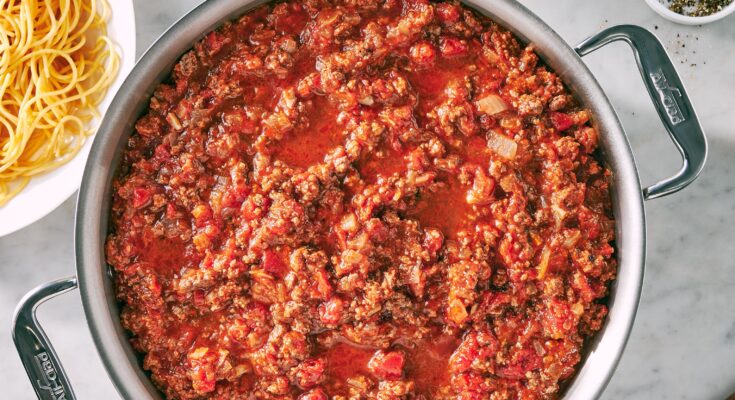Spaghetti Sauce Recipe: There’s nothing quite like the comforting aroma of a homemade spaghetti sauce simmering away on the stove. Whether you’re aiming to impress dinner guests or whip up a quick weeknight meal, a great spaghetti sauce can elevate any dish. But what exactly makes a good sauce? It all comes down to a combination of fresh ingredients, a bit of patience, and just the right amount of seasoning.
In this guide, I’ll take you through the step-by-step process to make a delicious, rich spaghetti sauce from scratch. No need to rely on jarred sauces—this homemade recipe is both easy to follow and endlessly customizable!
Ingredients for Spaghetti Sauce
Fresh Ingredients
- Tomatoes: Use fresh, ripe tomatoes if they’re in season, or opt for high-quality canned tomatoes like San Marzano for convenience.
- Garlic: Fresh garlic cloves bring out an aromatic depth.
- Onion: A yellow onion adds sweetness to balance acidity.
- Fresh Herbs: Basil and parsley lend a wonderful fragrance to the sauce.
Seasonings and Spices
- Salt and Pepper: To enhance flavors.
- Sugar: Just a pinch helps cut through the acidity of the tomatoes.
- Italian Seasoning: A mix of dried oregano, thyme, and basil works perfectly.
Optional Add-Ons for Extra Flavor
- Red Wine: Adds richness and depth to the sauce.
- Parmesan Rind: Throw one in for a cheesy umami kick.
- Chili Flakes: Perfect if you like a little heat.
Equipment You’ll Need
- Saucepan or Dutch Oven: For simmering the sauce.
- Wooden Spoon: To stir the ingredients without scratching the pan.
- Blender or Food Processor: Optional, if you prefer a smoother sauce.
Preparation Before Cooking
Peeling and Chopping Tomatoes
If using fresh tomatoes, blanch them in boiling water for a minute, then transfer to an ice bath to easily peel off the skins. Chop them roughly.
Preparing Garlic and Onion
Mince the garlic and dice the onion finely so they blend well into the sauce.
Measuring Out Herbs and Spices
Having everything ready before you start cooking ensures a smooth process without interruptions.
Step-by-Step Cooking Process
Step 1 – Sautéing Garlic and Onion
Heat olive oil over medium heat in your saucepan. Add the garlic and onion, stirring frequently, until they become fragrant and translucent. Be careful not to burn the garlic!
Step 2 – Adding Tomatoes and Breaking Them Down
Add the chopped fresh tomatoes (or canned tomatoes with their juices) into the pan. Use a spoon to crush them slightly and release their flavors.
Step 3 – Simmering the Sauce to Develop Flavor
Reduce the heat to low and let the sauce simmer uncovered for 30-40 minutes, stirring occasionally. This step allows the flavors to meld beautifully.
Step 4 – Adding Herbs, Spices, and Seasoning
Add your herbs, salt, pepper, and a pinch of sugar. If you’re using optional ingredients like red wine or Parmesan rind, add them now. Taste as you go to ensure the flavor is just right.
Pro Tips for Making the Perfect Sauce
How to Thicken the Sauce
If the sauce is too thin, continue simmering until it reduces to your desired consistency. Alternatively, you can stir in a bit of tomato paste.
How to Balance Acidity and Sweetness
If your sauce tastes too acidic, add a little more sugar. Alternatively, a splash of cream or butter can also soften the acidity.
Customizing Your Spaghetti Sauce
Meat Sauce Variation (Bolognese)
Add ground beef or Italian sausage to your onions and garlic in the first step for a hearty Bolognese sauce.
Vegetarian-Friendly Marinara Option
Skip the meat and stick to fresh herbs and vegetables for a lighter marinara sauce.
Adding Cream for a Rosa Sauce
Stir in a splash of heavy cream toward the end of cooking to make a creamy, tomato-based rosa sauce.
How to Store and Reheat Spaghetti Sauce
- Storing in the Fridge: Let the sauce cool completely before transferring it to an airtight container. It will last for up to 5 days in the fridge.
- Freezing the Sauce: Freeze portions in zip-top bags or containers for up to 3 months.
- Reheating for Best Flavor: Gently reheat the sauce over low heat, adding a splash of water if it thickened too much during storage.
Serving Suggestions
Pair your spaghetti sauce with classic spaghetti noodles or any pasta of your choice. A side of garlic bread and a crisp Caesar salad will complete the meal perfectly.
FAQs about Spaghetti Sauce Recipe
1. What ingredients are typically used in spaghetti sauce?
Traditional spaghetti sauce includes ingredients like tomatoes, garlic, onions, olive oil, herbs (basil, oregano), salt, pepper, and sometimes ground meat or vegetables. For added flavor, some recipes include sugar, red pepper flakes, or wine.
2. How do I thicken spaghetti sauce?
To thicken your sauce, simmer it uncovered to allow excess liquid to evaporate. You can also add a bit of tomato paste, cornstarch, or grated Parmesan cheese to achieve a thicker consistency.
3. Can I freeze homemade spaghetti sauce?
Yes, homemade spaghetti sauce freezes well. Store it in airtight containers or freezer bags, and it can last up to three months. Be sure to let it cool before freezing.
4. How long should I cook spaghetti sauce?
While a quick sauce can be ready in 20–30 minutes, simmering it for 1-2 hours allows the flavors to deepen and meld together. Slow-cooked sauces can be simmered for up to four hours for a richer taste.
5. What can I add to make spaghetti sauce taste better?
To enhance flavor, consider adding ingredients like a splash of red wine, a pinch of sugar to balance acidity, or fresh herbs such as basil and parsley. Grated Parmesan or a dash of balsamic vinegar can also add depth.
6. Can I use fresh tomatoes instead of canned?
Yes, fresh tomatoes work well, especially in the summer when they’re in season. Blanch and peel them first, then cook down to create a sauce with vibrant, fresh flavor.
7. How do I prevent spaghetti sauce from being too acidic?
To reduce acidity, try adding a pinch of baking soda or a small amount of sugar. Some also add carrots or onions to naturally sweeten the sauce and balance the acidity.
8. How do I store leftover spaghetti sauce?
Refrigerate leftover sauce in an airtight container for up to 4-5 days. For longer storage, freeze it in portions to make reheating easy.
Conclusion
Crafting the perfect homemade spaghetti sauce is both an art and a rewarding culinary experience. Whether you prefer a hearty meat sauce or a light marinara, experimenting with fresh herbs, spices, and tomatoes ensures every batch reflects your unique taste. With a bit of patience and creativity, you can elevate any pasta dish into a family favorite.
Remember, the best spaghetti sauces develop their flavors over time, so don’t hesitate to make a big batch and store some for later use. As you continue refining your recipe, you’ll discover the joy of homemade meals and the satisfaction of mastering this Italian classic. Now it’s time to gather your ingredients, dive in, and create a sauce that’s sure to impress. Bon appétit!
References
For further reading and validation of the tips and techniques shared in the Spaghetti Sauce Recipe with Post Links, it’s essential to explore information from trusted culinary resources. Below are a few reputable sources:
- AllRecipes – A trusted community-driven platform offering a variety of user-tested spaghetti sauce recipes with tips from home chefs.
- Bon Appétit – Known for its expert-tested recipes and insightful cooking advice, this source adds a gourmet touch to traditional sauces.
- BBC Good Food – A reliable platform with tried-and-true Italian recipes that cater to both beginners and seasoned cooks.
- The Spruce Eats – An extensive cooking resource offering both traditional and creative sauce recipes, along with preparation techniques.
These references provide additional insights and help validate the cooking methods highlighted in the article, ensuring readers can confidently recreate the dish at home.



